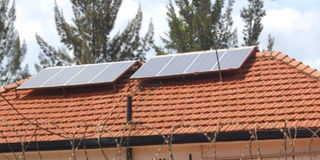Make a home friendly to the environment

Use solar energy to save energy by directly tapping it from the sun. file photos
Remember the village hut? The one built from only soil and sticks from the backyard. That was a true green building. Green buildings have nothing to do with the colour definitely, but a lot more to do with using construction techniques and materials that reduce the impact of one’s home and construction process on the environment, dubbed green architecture.
Optimal reuse of materials and conservation of resources for the betterment of the environment for future generations, according to Dr Dan Twebaze, the managing director, Twed Property Development Company, one of the companies pioneering this type of architecture, is one of their goals.
Reducing toxins
Unlike conventional architecture, green architectural buildings are built to generate their own energy with renewable non-toxic resources, captures and treats all its water, and operates efficiently on the least energy possible. Simply put: “Reducing the amount of hydrocarbons your home produces to the atmosphere, reducing the amount of energy used to run your home,” says architectural designer, Joe Nuwamanya–Okuuny, CEO Creation Architects.
He adds: “How sustainable, safe, energy efficient are the materials you are using in construction of your home or running your home reusable, if your answer to this is that they impact the environment minimally then I say you have gone green.”
Energy saving
Twebaze illustrates the answer to this. “We integrate the light sensitive bulbs that automatically turn on and off according to light sensitivity, and careful selection of window placement to allow in as much natural light during day. These work as sources of light for the building,” he says.
Another way these buildings save energy is the use of windows known as double glazed windows. These are specifically designed to keep the temperature moderate on the inside, and they have a blue glaze outside that reflects the heat keeping it on the outside. This works as a cooling and aeration system, replacing air conditioning that consumes unnecessary energy.
Twebaze further explains that all his buildings’ elevators use a belt and electromagnetic technology. “This means that we use only a tenth of the electricity compared to a mortar run kind of elevator,” he elaborates. All these methods aim at reducing on the amount of energy a building uses so that it can be utilised in other fields.
Nuwamanya, advises that to achieve a green architecture in your home design, more effort should be put in reducing your energy consumption levels. “If one already has a house in place, go for led bulbs as opposed to the ordinary tungsten bulbs, and use more efficient way of heating water not using wood or charcoal,” he says. Another safe option would be disconnecting the main electricity grid completely and using solar energy.
If you are just starting out on your construction process, he recommends using materials that don’t leave a higher carbon footprint in the manufacturing process such as earth stabilised blocks as opposed to cement blocks.
Water minimisation
Green architecture also includes effective water usage. This can be achieved by recycling water, using water fetched from the well and collection of rain water in tanks to supply the house. While these are good ways to utilise water in a home-based setting, they are not effective enough methods especially for large establishments like plazas or arcades.
In which case, the architects opt for water minimisation methods such as exploitation of gravity for water pressure.
Alternatively, the building owner can choose to use self-switch taps to lessen water wastage, or smaller holes for toilet flash that consumes as low as three litres.
And you will notice that all these methods also cater for human errors such as leaving a tap open.
Nuwamanya also recommends pumping water from underground using a wind mill, other than using connections from national water. Pumping water using a stationary bike, or even harvesting rain water and storing it in an overhead tank are also green options.
How to become greener in your household
•Turning off any lights or appliances when you don’t use them.
•Remembering that even when you’re not using something and it’s plugged in, it’s still eating away at potentially saved energy so unplug.
•Buying only recyclable containers and reusing plastics for food storage.
•Having safe and environmentally friendly alternatives for things like entertainment. Eliminating the extensive use of the television or the Internet is also a great way to get the family more involved with one another.
Safe and comfortable
The construction of a green building is strategically planned to utilise the light, the air, the energy and the view. These are done to benefit not only the environment but the people bound to use the building too.
Standing in one of the rooms at Twed Plaza, basking in the fresh air, enjoying the view of the Kololo Green Hills and with no distracting sound whatsoever, one cannot tell that this building is constructed on the side of a very busy road. Twebaze explains that, the view and a good working environment are not the only elements that make a green building every workers palace.
“These buildings are built using material like laminated glass, and less toxic provisions that are human safe.” And the best element of all is how pocket friendly this method of building can be to the owner in the long run in terms of monthly bills and maintenance costs.
“Going green is pretty much expensive from the onset, and finding a contractor or builder or architect that specializes in green building is equally going to be expensive, in this town they will come at cost as opposed to your regular build,” Nuwamanya shades some light the challenges of a green building. But enhanced durability, less maintenance costs, indoor environment quality, are what makes green architecture a better option and accessible. Like Twebaze likes to call it, “Having Champagne tastes with beer pockets.”




